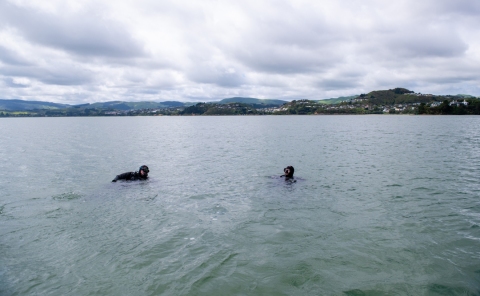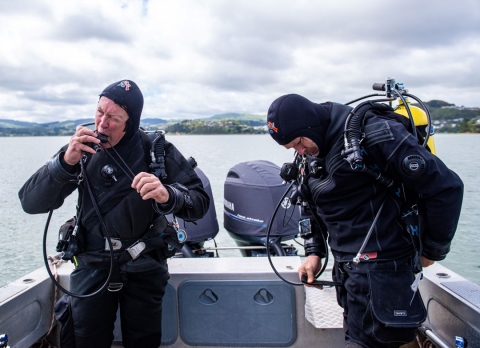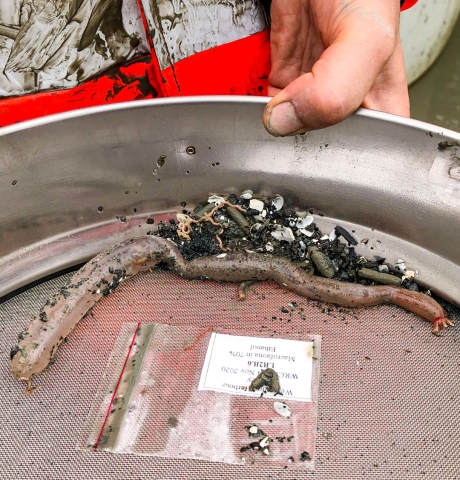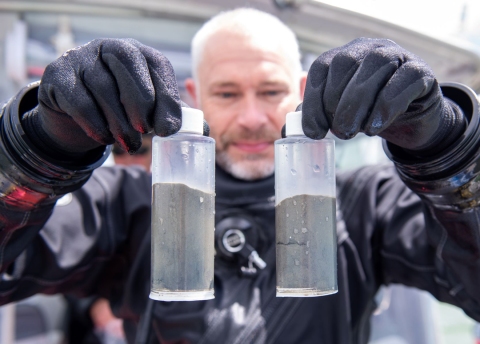Where there’s mud, there’s scientists.
NIWA divers recently got down and dirty while completing a harbour-wide dive survey in the Wellington area.
A NIWA dive team visited 20 sites in the Wellington and Porirua harbours during November working in low-visibility conditions to collect sediment samples from the seafloor.
The same survey is carried out every four years as part of Greater Wellington Regional Council’s Coastal Programme. Its aim is to understand the health of the harbours, including what contaminants are found in the seafloor sediments, where they are found and the types of animal communities living there.
NIWA Marine Ecologist Dr Vonda Cummings, who manages the survey for Greater Wellington, says the Wellington and Porirua Harbours are important environments for both marine life and people.
“There's a lot of life in and on the seafloor. Many people catch fish in the harbours and collect scallops and pāua, and there are a lot of nice places to visit.”
Started by Greater Wellington in 2004, Dr Cummings says the survey is important for documenting the current state of the harbours, in seafloor sediment types, contaminants and animal communities. By revisiting the same sites over time, it can also document important changes in the overall health of the harbour seafloor.
“It is designed to highlight areas where there might be reason for concern or, equally, where there have been improvements as well. This might be indicated by, for example, changes in the types of animal communities found.”
Greater Wellington senior coastal scientist, Dr Megan Melidonis, says the human impacts on the harbours are wide ranging.
“The key issues facing the estuaries flowing into these harbours are sedimentation, pollution, habitat loss, and ecological degradation. Increased sedimentation from land-based disturbances reduces the ability of the estuaries and coastal environments to support food gathering and recreation, or to protect us from storm surges and flooding. The information collected during these surveys allows us to direct remedial efforts where they will result in the greatest environmental recovery.”
Into the darkness
NIWA science diver Peter Marriott says the divers work in teams of two, at depths of up to 20 m in Wellington Harbour. They use rope lines on the seafloor to help with navigation, and they store their equipment and the samples they collect in a crate that is ‘connected’ to the surface via a rope and surface buoy. Mr Marriott says the “soft and floury” sediments are easily stirred up if the divers touch the seafloor.
November’s survey was one of the most challenging he’s done.
“It’s not particularly attractive. You can’t really see anything, - it’s not like diving in the tropics. It’s very muddy and hard work.”
Two types of sediment samples are collected at each site. The first are analysed for contaminants such as heavy metals.
The grain size of the sediment is also analysed to understand what kinds of sediments might be entering harbours following large rainfall events.
The second set of samples are later sieved to identify what and how many animals are living in the sediments.
If diving in near darkness wasn’t challenging enough, the divers also need the weather to play ball. “The survey collections take about two weeks, but in spring, it can be difficult to get a consecutive stretch of good weather.”
Wellington had awful weather in November, but the dive team were able to collect all the samples in the good days between the gale force winds and heavy rains.
Despite all that, Mr Marriott says the work certainly beats a day in the office.
The seafloor critters
While the samples from the 2020 survey are still being analysed, Dr Cummings says that during the initial processing of the seafloor samples NIWA researchers found a remarkable diversity of animals – including crabs, worms and shellfish.
Dr Cummings says that in past surveys up to 16 different species and more than 40 individuals have been found in a single sediment sample.
One of the most interesting animals found in the sediment samples was a ‘holothurian’, more commonly known as a sea cucumber.
Resembling a large, fleshy worm, the sea cucumber reproduces asexually, meaning it can split itself in half to create two sea cucumbers – this process is called transverse fission.
In a matter of minutes, three sea cucumbers did just that when researchers found them in the samples.
“It is fascinating what we find down there. The sea cucumber is a good example of the many unique animals that live in New Zealand harbours. Together these animals have an important role in keeping the sediments healthy, and providing food for larger animals that browse the seafloor. Muddy or sandy, these are important environments.”
1 / 6

NIWA divers Pete Notman and Peter Marriott in Porirua Harbour. [Photo: Sam Fraser-Baxter, NIWA]
2 / 6

The team on their way to conduct the mud survey. [Photo: Sam Fraser-Baxter, NIWA]
3 / 6

NIWA divers Pete Notman, left, and Peter Marriott prepare to get down and dirty in the Porirua Harbour mud. [Photo: Sam Fraser-Baxter, NIWA]
4 / 6

A sea cucumber collected during the mud survey prepares to split itself in two. [Photo: Sam Fraser-Baxter, NIWA]
5 / 6

- NIWA science diver Peter Marriot with sediment samples that will be analysed for contaminants and sediment size. [Photo: Sam Fraser-Baxter, NIWA]
6 / 6

NIWA diver Peter Marriott displays some sediment samples from the harbour mud survey. [Photo: Sam Fraser-Baxter, NIWA]
This story forms part of our 2020 Summer Series. Check out more stories from the series.
